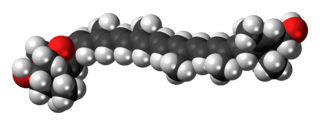Flavoxanthin
 | |
 | |
| Names | |
|---|---|
| IUPAC names
(2R,6S,7aR)-2- [(1E,3E,5E,7E,9E,11E,13E,15E)- 16-[(1R,4R)-4-Hydroxy- 2,6,6-trimethyl-1-cyclohex- 2-enyl]-1,5,10,14- tetramethylhexadeca- 1,3,5,7,9,11,13,15- octaenyl]-4,4,7a-trimethyl-2,5,6,7- tetrahydrobenzofuran-6-ol | |
| Other names
•5,8-Epoxy-5,8-dihydro-γ -carotene-3,3'-diol •all-trans-Flavoxanthin •E161a | |
| Identifiers | |
| 512-29-8 | |
| Jmol-3D images | Image |
| PubChem | 5281238 |
| |
| Properties | |
| C40H56O3 | |
| Molar mass | 584.87 g/mol |
| Appearance | Yellow solid |
| Melting point | 184 °C (363 °F; 457 K) |
| Except where noted otherwise, data is given for materials in their standard state (at 25 °C (77 °F), 100 kPa) | |
| | |
| Infobox references | |
Flavoxanthin is a natural xanthophyll pigment with a golden-yellow color found in small quantities in a variety of plants. As a food additive it used under the E number E161a as a food coloring although it is not approved for use in the EU[2] or USA. It is listed as food additive 161a in Australia and New Zealand where it is approved for usage as an ingredient in food products.[3]
References
- ↑ Merck Index, 11th Edition, 4032.
- ↑ UK Food Standards Agency: "Current EU approved additives and their E Numbers". Retrieved 2011-10-27.
- ↑ Australia New Zealand Food Standards Code"Standard 1.2.4 - Labelling of ingredients". Retrieved 2011-10-27.